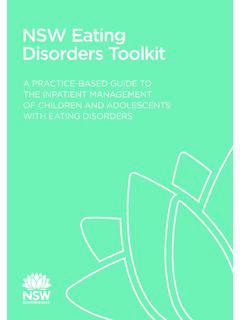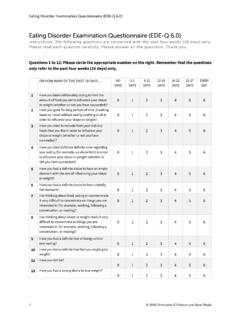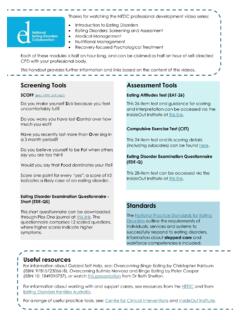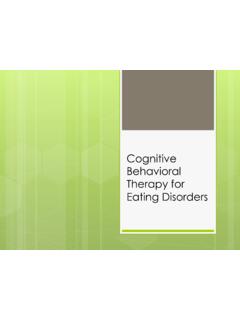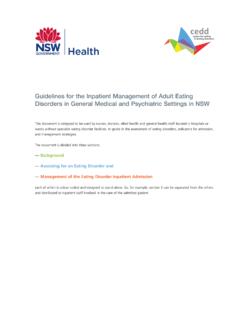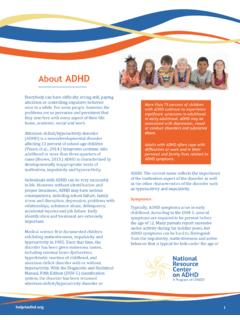Transcription of EATING DISORDER EXAMINATION - CREDO-OXFORD
1 1 EATING DISORDER EXAMINATION (Edition ; April, 2014) Copyright by Christopher G Fairburn, Zafra Cooper and Marianne O'Connor, 2014 OVERVIEW OF EDE The seventeenth edition of the EDE is the latest version of this widely used instrument. All the changes from the previous edition (EDE ; Fairburn, Cooper, and O Connor, 2008) arise from the need to generate DSM-5 EATING DISORDER diagnoses. The major changes are as follows: i. The item on menstruation has been removed as it is no longer a diagnostic criterion for anorexia nervosa ii. The diagnostic items focus exclusively on the past three months as the six-month time frame for binge EATING DISORDER has been reduced to three months iii. References to whose weight might make them eligible for the diagnosis of anorexia nervosa have been replaced by whose weight might be viewed as significantly low In all other significant respects the instrument is the same as EDE Edition generates EDE data.
2 GENERAL GUIDELINES FOR INTERVIEWERS The EDE is an investigator-based interview. This may be contrasted with respondent-based interviews in which the participant's answers to specified questions are rated without additional questioning. Respondent-based interviews are in essence verbally administered self-report questionnaires. They work well where the concepts being assessed are simple and there is general agreement as to their meaning, but they are unsatisfactory when the concepts are complex or key terms do not have a generally accepted specific meaning. With investigator-based interviews interviewers need training to ensure that they fully understand the concepts being assessed. The structure in such interviews lies in the detailed specifications provided for the interviewer of the concepts to be rated and the rating scheme, rather than in the precise wording of individual questions.
3 In summary, investigator-based interviews such as the EDE require that interviewers be trained both in the technique of interviewing and in the concepts and rules governing the ratings. When using the EDE, it is essential that the participant understands the purpose of the interview. The interviewer should explain why the interview is being conducted and, before starting formal questioning, should aim to establish good rapport. The interviewer and participant together should be trying to obtain an accurate picture of the participant's current EATING behaviour and attitudes. It is important to explain that a standard set of questions is being asked and that some may not apply. Participants also need to know in advance how long the interview will take. At a minimum this will be 45 minutes but it can take as long as an hour and a quarter.
4 (EDE interviews should rarely be allowed to take longer than this since otherwise interviewer and participant fatigue will affect the quality of the 2 ratings.) The interviewer should explain that the interview mainly focuses on the preceding four weeks (28 days), although if the interview is also being used for diagnostic purposes certain questions extend out to cover the previous three months. To help the participant accurately recall the primary period of interest, time should be devoted at the beginning of the interview to the identification of events which have taken place during these 28 days. For example, the interviewer should establish whether the participant has been at home or away and what has happened on each of the four weekends. It can be helpful referring to a prepared calendar to locate the four weeks in question (see below).
5 If the interview is also being used for diagnostic purposes events of note in (28-day) months 2 and 3 (counting back from the present 28 days) should also be noted together with their boundaries. Rarely should the orientation to the time frame be allowed to take more than 10 minutes. Each of the items in the EDE has one or more (asterisked) obligatory questions in bold type which must be asked. Special emphasis should be placed upon the words and phrases that are underlined. The obligatory questions should be supplemented with additional questions of the interviewer's choice. The phrase "over the past four weeks" which precedes most obligatory question may be varied as seems appropriate ( , "over the past month" or "over the past 28 days") and inserted at any point within the question, but otherwise the obligatory questions should be asked as specified in the schedule.
6 The items in the interview may be covered in any order although for most purposes the sequence presented in the schedule will be found to be satisfactory. It is perfectly appropriate to return to earlier items if further information emerges during the interview which is of relevance to prior ratings. The interview should never be undertaken in the absence of the full schedule as even the most experienced interviewers need to refer to the questions, definitions, and rating schemes. The interviewer should pay careful attention to everything that the participant says. The interview should never be hurried. It should proceed at a steady relaxed pace with the interviewer not moving on to the next item until he or she is satisfied that all the necessary information has been obtained.
7 The interviewer should not be rushed along by rapid, and possibly impatient, replies. Apparently glib answers which do not seem to have been given thought should be sensitively explored. Conversely, participants who are loquacious and over-detailed in their replies need to be kept to the point. Care must always be taken to ensure that the participant understands what information the interviewer is trying to elicit. It is good practice to check back with the participant before making each rating. The physical circumstances under which the interview is conducted are also important. The interviewer and participant need to be comfortably seated and the interviewer needs to be able to have the schedule in front of him/her together with the rating sheet. There should be as few distractions as possible and except under unusual circumstances no one else should be present since otherwise participants tend not be to be frank and forthcoming.
8 Guidelines for making ratings are provided for most items. Ratings should be made as the interview proceeds (although certain calculations may be delayed until afterwards). The instructions for making the ratings are given in square brackets and they are followed by the rating scheme itself. Frequency ratings should be based on a 28-day month: if a feature is not present, rate 0; if a feature is present on up to and including 5 days, rate 1; if it is present half the time, rate 3; if it is present almost every day (with up to and including 5 exceptions), rate 5; if it is present every day, rate 6. Some items are rated on a seven-point severity scale ranging from 0 to 6. In these cases 0 represents the absence of the feature in question and 6 represents its presence to an extreme degree; a rating of 1 should be made only if the feature is barely present, and a rating of 5 should be made only if the feature is present to a 3 degree not quite severe enough to justify a rating of 6.
9 A rating of 3 should be used for degrees of severity midway between 0 and 6. If it is difficult to decide between two ratings, the lower rating ( , the less symptomatic) should be chosen. [The exception is the first item "Pattern of EATING " in which higher scores are (with the exception of nocturnal EATING ) less symptomatic.] This general rating scheme is summarised in Table 1. SCORING The EDE, and its self-report version, the EDE-Q, generate two types of data. First, they provide frequency data on key behavioural features of EATING disorders in terms of number of episodes of the behaviour and in some instances number of days on which the behaviour has occurred. Second, they provide subscale scores reflecting the severity of aspects of the psychopathology of EATING disorders .
10 The subscales are Restraint, EATING Concern, Shape Concern and Weight Concern. To obtain a particular subscale score, the ratings for the relevant items (listed below) are added together and the sum divided by the total number of items forming the subscale. If ratings are only available on some items, a score may nevertheless be obtained by dividing the resulting total by the number of rated items so long as more than half the items have been rated. To obtain an overall or global score, the four subscales scores are summed and the resulting total divided by the number of subscales ( four). Subscale scores are reported as means and standard deviations. Subscale Items (the numbers are the item number on the EDE-Q): Restraint 1 Restraint over EATING 2 Avoidance of EATING 3 Food avoidance 4 Dietary Rules 5 Empty stomach EATING Concern 7 Preoccupation with food.


